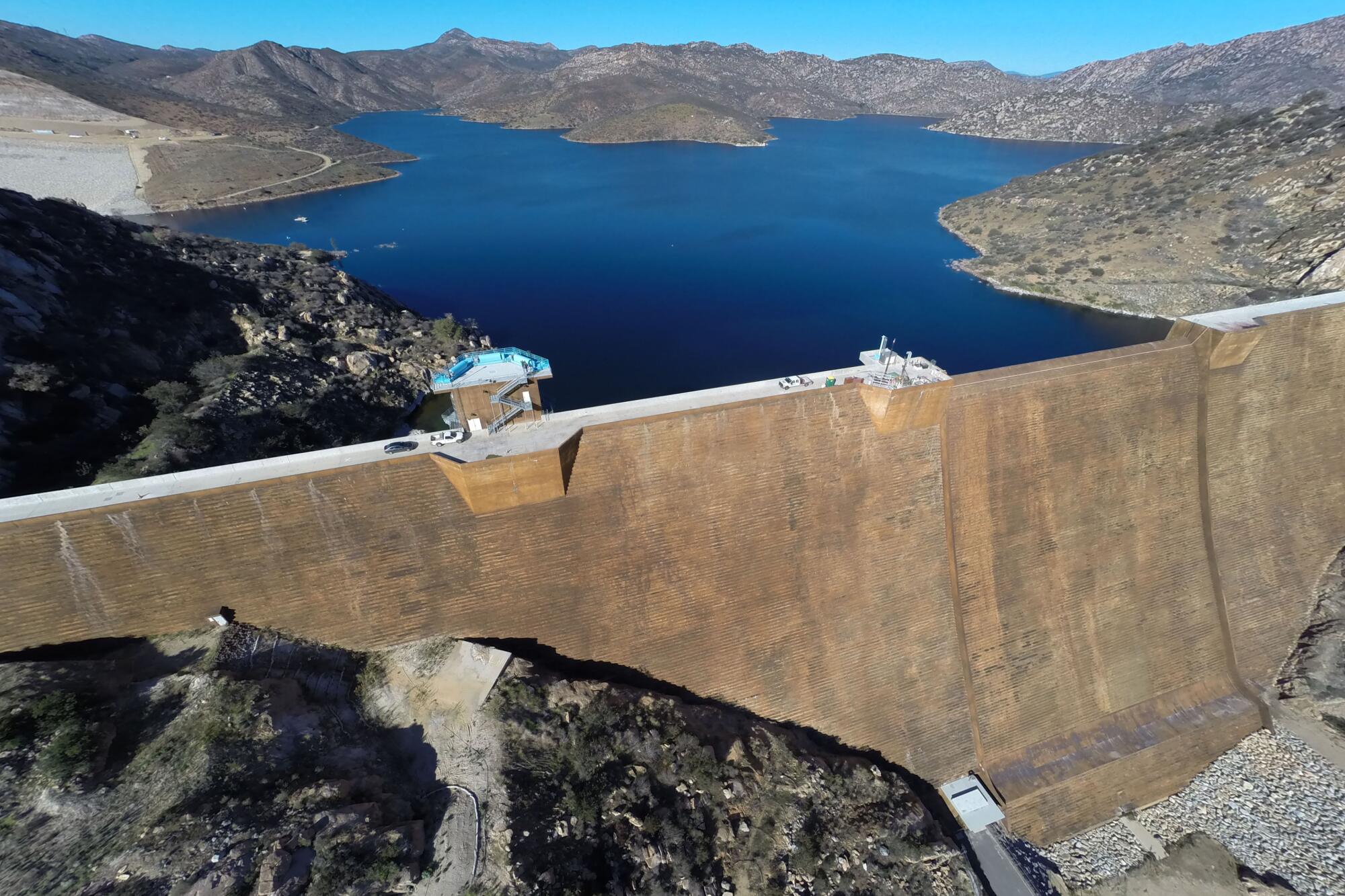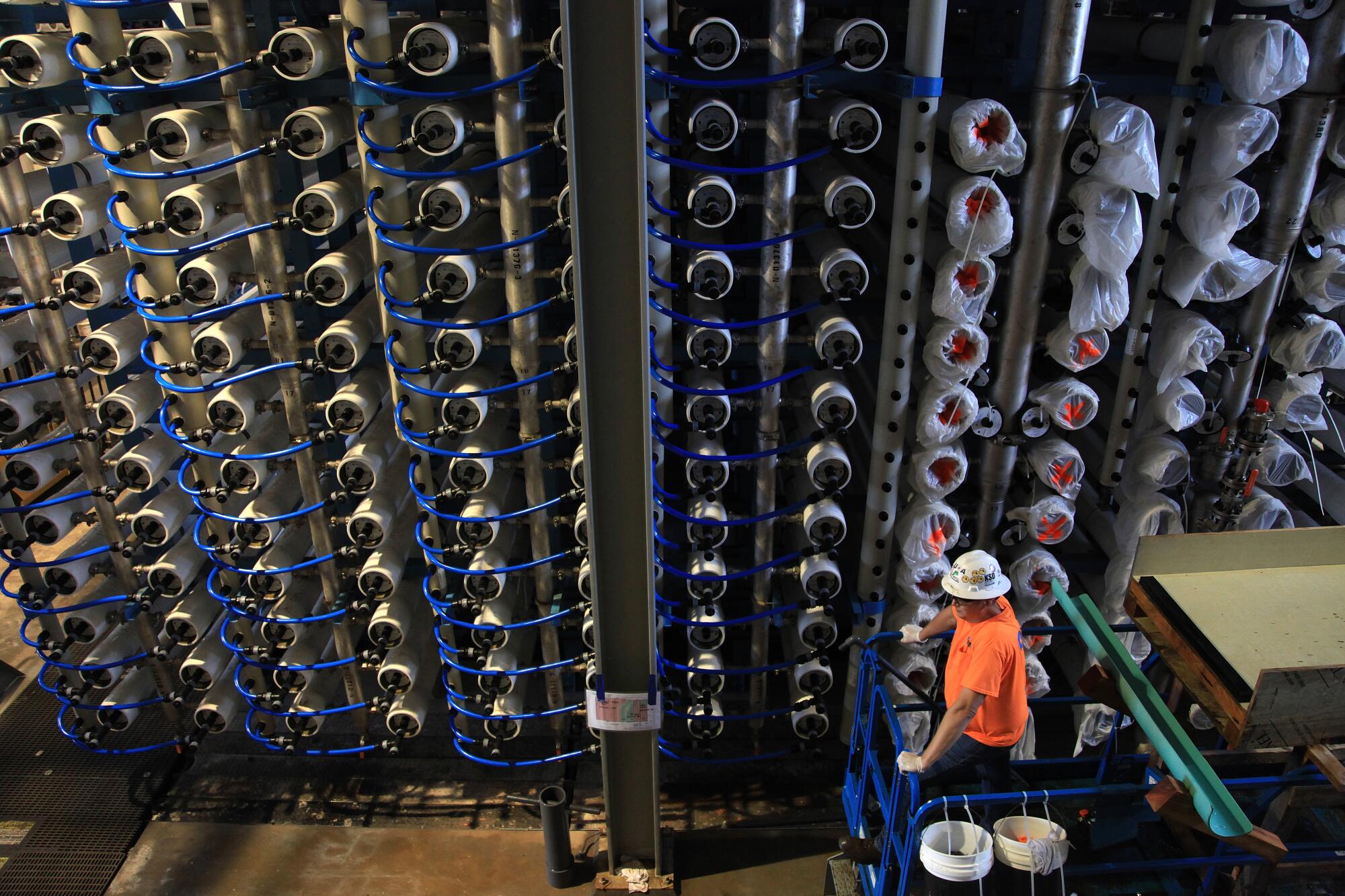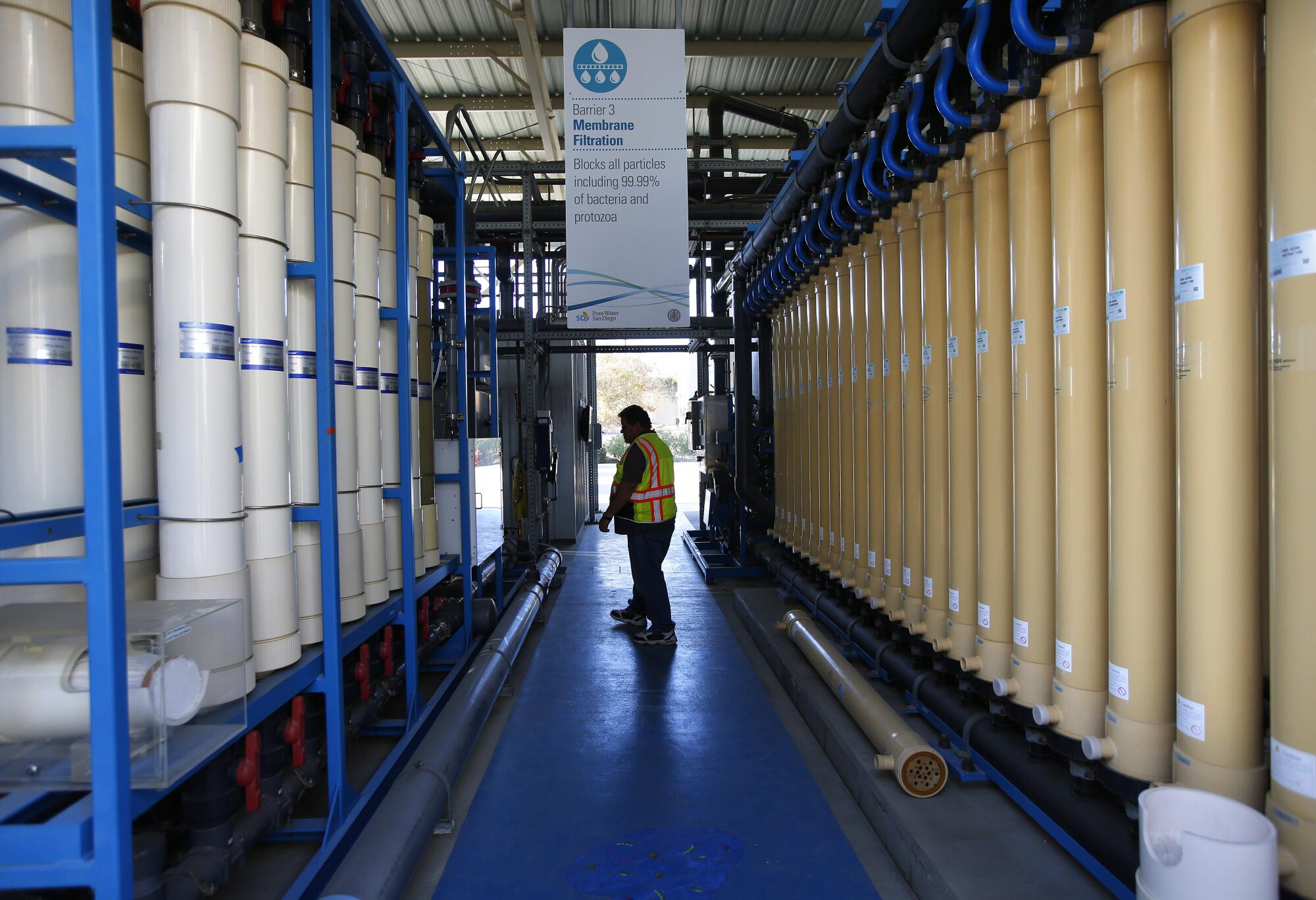
- Share via
SAN DIEGO — San Diego is at the end of the pipeline when it comes to importing water from the Colorado River and the Sacramento Bay Delta. So it’s no surprise its costs have exceeded those of Los Angeles and other parts of Southern California.
However, a recent report from a leading expert finds there’s more behind the skyrocketing price of water in the San Diego region, which over the last decade has seen wholesale rates increasingly outpace neighbors to the north.
Plummeting demand coupled with a bevy of costly projects — from raising dams to a desalination plant in Carlsbad — created a perfect storm that sent water rates soaring over the last decade, according to a recent analysis by longtime environmental economist Michael Hanemann of Arizona State University.
Hanemann doesn’t fault the San Diego County Water Authority for its investments. He said the strategy of the wholesaler, which serves 24 retail agencies, would look more prudent today had demand not unexpectedly fallen by 40% since 2010.
Over the last decade, multiple droughts in California have triggered mandatory conservation coupled with a widely successful turf-rebate program. Demand across the state has decreased dramatically. Most agencies didn’t see it coming.
As a result of selling less water, the water authority has had to hike rates to cover its annual expenses — nearly 90% of which are fixed costs, including payments on $21 billion in debt, according to the report.
“This infrastructure will get used,” Hanemann said. “Maybe it won’t get used as much as expected this decade, but three decades from now, it will be used. The problem is timing.”
The water authority — which declined an interview request for this story — has maintained that its investments were wise and ensure the region isn’t faced with crippling shortages during drought.
Critics have countered that the agency has, to its own detriment, ignored the plight of farmers and cash-strapped residents who are often more sensitive to cost than mandatory cutbacks. Now the region’s high prices are likely driving increased conservation, and vise versa.
“Everyone missed that price has an impact on demands,” said Jack Bebee, general manager of the Fallbrook Public Utility District. “Eventually, there’s a point where people say, ‘$400 a month for a lawn isn’t worth it.’ That’s still being overlooked.”
The water authority has repeatedly overestimated demand since 1995 — initially predicting regionwide water use would reach 970,000 acre feet by 2020. Today, the region is using about half that, around 450,000 acre feet, down from a peak of roughly 700,000 acre feet in 2007.
Those skeptical of the water authority have questioned whether the agency overbuilt its system in a somewhat misguided effort to insulate itself from the L.A.-based Metropolitan Water District of Southern California.
The district provided 95% of San Diego’s water before a dustup over drought restrictions in the early 1990s. Today, that figure is down to 11%, thanks to San Diego’s investments in desalination, recycling and, most notably, a deal for Colorado River water with the Imperial Irrigation District.
Ratepayers could have benefited from more collaboration between the two agencies, Hanemann said. “The bad blood that has existed between [the San Diego] Water Authority and Metropolitan has really been harmful to the region.”
That has put the spotlight on the widening gap between what the San Diego Water Authority and Metropolitan Water District charge for untreated water: now $1,474 an acre foot and $1,075, respectively, according to the report. (An acre foot is enough water to cover an acre a foot deep, or 325,851 gallons.)
Part of that differential stems from San Diego’s particularly aggressive conservation, according to the report. Metropolitan saw its demand drop by just 20% since 2010, half of the decline experienced by the San Diego authority.
The other side of the equation is the water authority’s recent slate of capital projects, such as its roughly 16-year, $1.5-billion effort to expand emergency storage, including the raising of San Vicente Dam. Completed in 2014, the ambitious endeavor nearly doubled the capacity of the region’s primary reservoir.

Highly focused on reliability, the wholesaler also inked a deal with Carlsbad-based Poseidon Water to build a $1-billion desalination plant in its hometown. The water authority signed a 30-year contract to pay for continuous supplies whether it needs them or not.
The cost for this desalinated water is an eye-popping $2,725 an acre foot. The report found that last year the region could have shaved about $215 off its wholesale cost for an acre foot untreated water had it not been obligated to purchase the desalinated water.
“Desal’s a boondoggle,” said Matt O’Malley, executive director and attorney for San Diego Coastkeeper, who opposed the project from the beginning.
He and other environmental advocates urged the city of San Diego to embrace wastewater recycling over desalination over a decade ago. Instead, city officials shelved what was then dubbed “toilet to tap,” clearing the way for the deal with Poseidon.
In recent years, the city of San Diego has revived its sewage-recycling plan, under the name Pure Water. However, with legacy investment like desalination far from paid off, many worry an all-of-the-above strategy will create further financial hardship for ratepayers.
The report did find that the desalination plant gave the water authority more leverage to negotiate with state regulators over mandatory water cutbacks during the last drought. While rural, agricultural districts haven’t been happy with that tradeoff, supporters say the increased reliability will be crucial as climate change takes an ever greater toll on mountain snowpack.
“I think if the state were smart, it would probably build five to 10 desal plants up and down the state,” said Jim Madaffer, a former San Diego City city council member who serves on the water authority’s board. “That would probably solve a lot of the problems.”

Tom Kennedy, general manager of the heavily agricultural Rainbow Municipal Water District, couldn’t disagree more. He said the water authority should have forgone the project, acknowledging the emerging trends in long-term conservation and declining sales.
“Demands were going down but everyone said, ‘Oh, it’s the great recession,” he said. “They never look at it as systemic. Now the inflection point of reliability at any price is right here in front of us.”
That’s been especially true of the agricultural sector, which purchased about 98,000 acre feet of supplies from the water authority in 2007. Farmers’ desire for water now hovers around 28,000 acre feet a year.
The agency still maintains hope that demand will eventually rise with population growth. It’s also increasingly acknowledged the impact of rising rates, given the precarious economic conditions plaguing many parts of the region. It recently formed a Financial Strategy Working Group. On Thursday, staff made a presentation to members of the agency’s board.
Its approach focused on ways to publicly convey the relative affordability of tap water, comparing it to everything from gasoline to milk. Several board members balked at the proposed messaging campaign, saying the agency should be more focused on figuring out how to help struggling residents.
“While the cost of water may seem small compared to other areas, for folks living at the margins … they may be prioritizing medical assistance, food, just having a roof over their heads,” said Ismahan Abdullahi, who represents the city of San Diego on the water authority board.
Kennedy echoed that sentiment: “From a financial strategy, it should be, ‘What is it we can do to make water more affordable?’ I hope as we go forward with this process, we can spend a little more time looking inward.”
While the cost of water in San Diego is only expected to increase, L.A.’s rates could eventually catch up, Hanemann said. That’s because the Metropolitan Water District has its own ambitious plans to invest in new wastewater recycling and will eventually be required to help fund a long-envisioned overhaul of the Bay Delta’s conveyance system, which is vulnerable to earthquake and sea-level rise.
Hanemann said it’s challenging for water officials to balance future demand against the need for expensive new projects, which can require decades before coming to fruition.
“It’s the brutal economic fact of water supply: It’s not nimble,” he said.
More to Read
Sign up for Essential California
The most important California stories and recommendations in your inbox every morning.
You may occasionally receive promotional content from the Los Angeles Times.











